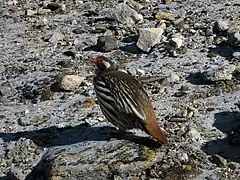| Tetraogallus[1] | |||
| J.E. Gray, 1832[2] | |||
 Przedstawiciel rodzaju – ułar tybetański (T. tibetanus) | |||
| Systematyka | |||
| Domena | |||
|---|---|---|---|
| Królestwo | |||
| Typ | |||
| Podtyp | |||
| Gromada | |||
| Podgromada | |||
| Infragromada | |||
| Rząd | |||
| Rodzina | |||
| Podrodzina | |||
| Plemię | |||
| Rodzaj |
Tetraogallus | ||
| Typ nomenklatoryczny | |||
|
Tetraogallus nigellii J.E. Gray, 1832 (nie Lophophorus nigelli Jardine & Selby, 1829) (= Tetraogallus himalayensis G.R. Gray, 1843) | |||
| Synonimy | |||
|
| |||
| Gatunki | |||
| |||
Tetraogallus – rodzaj ptaków z podrodziny bażantów (Phasianinae) w rodzinie kurowatych (Phasianidae).
Zasięg występowania
Morfologia
Długość ciała 50–72 cm, rozpiętość skrzydeł 80–105 cm; masa ciała 1170–3629 g (samce są większe i cięższe od samic)[10].
Systematyka
Etymologia
- Tetraogallus (Setraogallus): zbitka wyrazowa nazw rodzajów: Tetrao Linnaeus, 1758 (głuszec) oraz Gallus Brisson, 1760 (kur)[11].
- Chourtka (Chourtha): według Wiktora Moczulskiego Chourtka to nazwa nadana ułarowi kaukaskiemu przez górskie plemiona[12]. Gatunek typowy: Chourtka alpina Motschoulski, 1839 (= Tetrao caucasica Pallas, 1811).
- Megaloperdix: gr. μεγας megas, μεγαλη megalē „wielki”; περδιξ perdix, περδικος perdikos „kuropatwa”[13]. Gatunek typowy: Tetrao caucasica Pallas, 1811.
- Oreotetrax: gr. ορος oros, ορεος oreos „góra” (tj. Kaukaz); τετραξ tetrax, τετραγος tetragos „ptak łowny” (prawdopodobnie pardwa lub perliczka)[14]. Gatunek typowy: Tetrao caucasica Pallas, 1811.
- Montigallus: łac. mons, montis „góra”; gallus „kogucik”[15]. Gatunek typowy: Tetraogallus tibetanus Gould, 1854.
Podział systematyczny
Do rodzaju należą następujące gatunki[16]:
- Tetraogallus caucasicus – ułar kaukaski
- Tetraogallus caspius – ułar kaspijski
- Tetraogallus himalayensis – ułar himalajski
- Tetraogallus tibetanus – ułar tybetański
- Tetraogallus altaicus – ułar ałtajski
Przypisy
- ↑ Tetraogallus, [w:] Integrated Taxonomic Information System (ang.).
- ↑ J.E. Gray: Illustrations of Indian zoology; chiefly selected from the collection of Major-General Hardwicke, F.R.S.. Cz. 2. London: Treuttel, Wurtz, Treuttel, Jun. and Richter, 1832, s. ryc. 46. (ang.).
- ↑ W. Motschoulski. Chortka genre nouveau de Gallinacées. „Bulletin de la Société impériale des naturalistes de Moscou”. 12, s. 94, 1839. (fr.).
- ↑ J.F. von Brandt. Bericht über die Beiercherungen des Zoologischen und Zootomischen Museums der Kaiserl. Akademie der Wissenschaften während des 1840sten Jahres. „Bulletin Scientifique / Académie Impériale des Sciences de Saint Petersbourg”. 8 (12), s. kol. 190, 1841. (niem.).
- ↑ G.R. Gray: The genera of birds: comprising their generic characters, a notice of the habits of each genus, and an extensive list of species referred to their several genera. Cz. 3. London: Longman, Brown, Green, and Longmans, 1849, s. 502, 503. (ang.).
- ↑ J. Cabanis: Oreotetrax. W: J.S. Ersch, J.G. Gruber: Allgemeine Encyclopädie der Wissenschaften und Künste. Leipzig: F. A. Brockhaus, 1846, s. 144. (niem.).
- ↑ T.C. Eyton: A catalogue of the species of birds in his possession. Wellington, Salop: printed by R. Hobson, 1856, s. 307. (ang.).
- ↑ R.L. Potapov. History of description of the genus Tetraogallus and designation of the type species of the subgenera Tetraogallus and Montigallus (Potapov 1991). „Русский орнитологический журнал”. 24, s. 1133, 2015. (ros. • ang.).
- ↑ F. Gill & D. Donsker: Pheasants, partridges & francolins. IOC World Bird List: Version 8.2. [dostęp 2018-09-06]. (ang.).
- ↑ P.J.K. McGowan: Family Phasianidae (Pheasants and Partridges). W: J. del Hoyo, A. Elliott & J. Sargatal: Handbook of the Birds of the World. Cz. 2: New World Vultures to Guineafowl. Barcelona: Lynx Edicions, 1994. ISBN 84-87334-15-6. (ang.).
- ↑ The Key to Scientific Names ↓, Tetraogallus [dostęp 2018-09-05].
- ↑ The Key to Scientific Names ↓, Chourtka [dostęp 2018-09-05].
- ↑ The Key to Scientific Names ↓, Megaloperdix [dostęp 2018-09-05].
- ↑ The Key to Scientific Names ↓, Oreotetrax [dostęp 2018-09-05].
- ↑ The Key to Scientific Names ↓, Montigallus [dostęp 2018-09-05].
- ↑ Systematyka i nazwy polskie za: P. Mielczarek & M. Kuziemko: Plemię: Coturnicini Reichenbach, 1848 (wersja: 2017-05-11). [w:] Kompletna lista ptaków świata [on-line]. Instytut Nauk o Środowisku Uniwersytetu Jagiellońskiego. [dostęp 2019-09-06].
Bibliografia
- The Key to Scientific Names, J.A. Jobling (red.), [w:] Birds of the World, S.M. Billerman et al. (red.), Cornell Lab of Ornithology, Ithaca (ang.).
This article is issued from Wikipedia. The text is licensed under Creative Commons - Attribution - Sharealike. Additional terms may apply for the media files.